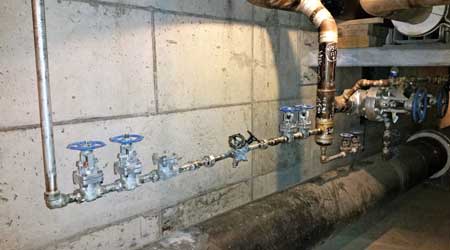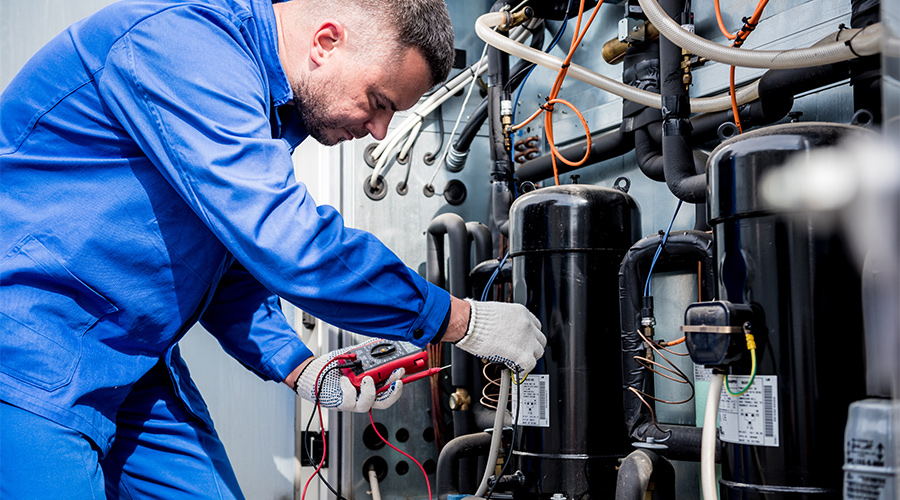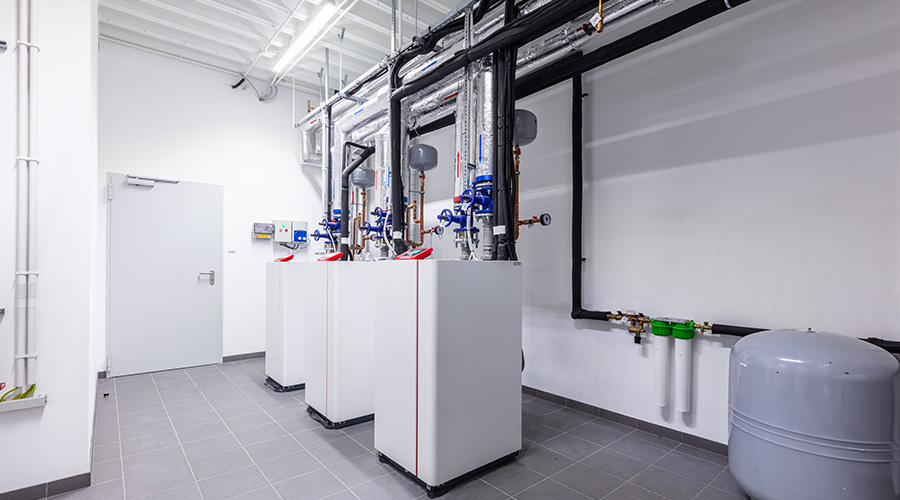How to Get the Most from a Condensate Recovery System
For steam distribution, condensate recovery system is key to safety, reliability, and costs.
Steam has long been used to deliver heat to buildings connected to a district heating system, such as those found on college campuses. High heat capacity, relatively low cost of generation, and ease of conveyance make steam an efficient method of delivering thermal energy to a large area, but steam distribution systems require some careful considerations. Proper design, installation, operation, and maintenance can significantly lower the risk of a catastrophic failure. Efficient condensate removal is not only key to the safety and reliability of any steam distribution system, but maximizing recovery rates can help decrease operational costs.
Condensate Removal
The removal of condensate from steam distribution mains is essential to maintain a safe and efficient central heating system. Allowing water to enter building mechanical rooms and get into the steam space of heat exchanger systems will reduce heat transfer and can lead to premature damage of flange gaskets, control valves and other components. Allowing water to accumulate in the steam distribution mains can also lead to potentially dangerous occurrence known as water hammer
Two types of water hammer can occur in a steam distribution system. The first is a steam-flow-driven water hammer, which occurs when a slug of moving water hits an object and suddenly stops. Design of hydronic piping systems typically limit fluid velocities to roughly 10 feet/second, while steam distribution lines are often designed for velocities of up to 100 feet per second or more. When condensate is allowed to pool at the bottom of a steam line, ripples or “waves” can begin to form and eventually a slug can be picked up and carried downstream at essentially the same velocity as the steam. When the slug of condensate hits an obstruction like a valve or an elbow, the slug’s kinetic energy is converted to pressure energy and the result can range from subtle noise and movement of the pipe, to more severe cases of rupture and escape of live steam.
The second type of water hammer is condensate-driven, also known as steam hammer. Steam hammer occurs when a pocket of steam is surrounded by relatively cool condensate and collapses into a liquid state. Water in steam form takes up about 1,600 times more volume than an equivalent mass as a liquid, so when steam condenses into water, it shrinks by a considerable amount and creates a vacuum. The vacuum will pull the surrounding water together to fill the void, creating a violent collision. These collisions happen almost instantaneously and can be violent enough to cause pipes to rupture or valves and other components to break.
The key to avoiding each of these situations is the proper removal of condensate, which is most effectively accomplished with the use of steam traps and proper system start-up procedures.
Steam Trap Selection
The type of steam trap selected for any steam distribution system must not only meet supply pressure and load requirements, but also requirements for air venting, response to pressure and load changes, resistance to dirt, and resistance to water hammer. There are three main categories of steam traps, and each one has particular attributes that make it more suitable for certain applications.
The first category is mechanical traps. These include:
• Float and Thermostatic: These traps consist of a ball attached to a lever and a valve head. Condensate enters the trap and raises the float until the liquid level pulls the valve off its seat to allow discharge. A thermostatically operated air vent automatically vents air that accumulates inside the housing.
Advantages – Excellent air removal capabilities at start-up and during normal operation.
Disadvantages – Limited to lower pressure systems, generally less than 30 PSIG (pounds per square inch gauge).
• Inverted Bucket Traps: An inverted bucket is surrounded by water which causes it to float. Operation of this trap always requires the body to be filled with water to be primed. The bucket is attached to a lever and valve which operates when changes in buoyancy cause the bucket to drop, pulling the valve head off its seat and discharging accumulated air or excess condensate.
Advantages – Excellent ability to withstand high pressures.
Disadvantages – Limited ability to discharge air or other non-condensable gasses. May lose prime and fail open with rapid pressure drop due to sudden load swings. Relatively stable systems such as campus distribution usually see much more gradual load changes.
The second category is thermostatic traps. Bimetallic traps are most common type of thermostatic trap in use. This trap consists of strips or discs made of two different types of metal with different coefficients of thermal expansion. This means that the two different materials will expand differently at a given temperature, causing the disc to bend or arch, which can be used to open or close a valve.
Advantages – Ability to withstand water hammer and discharge large amounts of condensate relative to its physical size. Can discharge air and non-condensable gasses well but may close before all gasses are released.
Disadvantages – Because they operate well below the saturation point, there will always be a backup of condensate upstream of the trap. They are temperature-dependent so response time is very slow which can cause steam to leak by. They are also highly susceptible to dirt clogging the valve mechanism.
The third category is thermodynamic traps. Most thermodynamic traps operate with a free-floating disc that is forced up and down by pressure changes caused by the flashing of steam on the discharge side of the trap. It is a cyclical pattern, and because it is closed by flash steam created from hot condensate, there is a small amount of subcooling and back-up of condensate in the system. A proper drip leg is required when using thermodynamic traps.
Advantages – Excellent ability to withstand water hammer and operate consistently across their entire pressure range.
Disadvantages – Cannot be operated at low pressures (~5 PSIG and below) or very high backpressure (roughly 80 percent of steam pressure). Can be vulnerable to dirt getting trapped between the disc and seat.
Start-up Procedures
Steam traps for a steam distribution system should be sized to handle the pressure and load profile they will see during normal and peak operating conditions, but attention should be given to start-up loads as well. This will depend on the start-up method employed to bring the system up to full temperature and pressure. The two methods most typically used are supervised start-up and automatic start-up.
With supervised start-up, a manual drain is installed at each drip leg and opened to atmosphere, bypassing the steam trap. When steam is first introduced into the cold main lines it will be at a relatively low pressure and much of the steam’s thermal energy will be given up to heating the pipes, creating a large amount of condensate. As temperature and pressure in the steam mains rise, the manual valves are closed and the steam traps can be left to operate under normal conditions. In this case, the traps need to be sized only for operating conditions as the excess condensate generated during warm up is manually drained out of the system.
This procedure is used most often in large heating systems where start-up is infrequent.
Automatic start-up is used in some smaller systems, where the boiler is fired and brought to pressure with the distribution valves open. In these cases, the steam mains and branch lines come up to temperature and pressure without supervision and the steam traps are relied on to discharge the condensate generated during warm-up.
This method is commonly used in very small process facilities that are started frequently, such as dry cleaners that shut down at night and are restarted each morning. It is not common, nor is it recommended to employ such a start-up method on a large and complicated distribution system.
Cost of Condensate
Although safety is the highest priority, there is also a significant financial advantage to maintaining an efficient condensate recovery system. Consider a Midwestern university campus with 6,000,000 square feet of building space heated by a natural-gas-fired steam boiler plant. Typical operating costs for the boiler plant are:
• Natural gas: $4.50 per million BTUs
• Water and sewer charges: $9.00 per 1,000 gallons
• Water treatment: $2.00 per 1,000 gallons
Condensate that is not returned to the plant for use in the feedwater system must be replaced with raw make-up water. For the purposes of this calculation, it is assumed that the average temperature of the condensate returned from campus is 150 degrees F and the average temperature of raw make-up water is 55 degrees F. The theoretical thermal energy required to heat raw make-up water to the temperature of the returned condensate is therefore 95 BTU/lb., or roughly 792,000 BTU per 1,000 gallons of water. Assuming an average boiler efficiency of 80 percent, this equates to an actual energy requirement of 990,000 BTU to heat 1,000 gallons of raw water up to the temperature of the returned condensate. Using the natural gas cost listed above leads to a total fuel cost of $4.46 per 1,000 gallons.
The raw make-up water must also be treated before it is sent to the boiler. Adding the cost of chemicals and operational costs of the pre-treatment systems gives a total cost of $15.46 per thousand gallons of raw make-up water needed to replace the condensate that is not returned to the plant.
Based on typical building loads, expected distribution losses, and in-plant steam consumption, the annual steam production for this boiler plant may be on the order of 650,000,000 pounds. If the distribution system returns only 40 percent of its condensate, more than $720,000 is wasted to make up for the water, chemicals, and thermal energy that is lost throughout the campus distribution system. The potential savings are more than enough to help justify condensate recovery projects such as new receivers and pumps, pipe repairs, or system upgrades.
David Mercer (david.mercer@rmf.com), PE, is a mechanical engineer with RMF Engineering with experience in the analysis and design of steam and chilled water generation and distribution systems in campus environments. His expertise includes utility metering, energy optimization, and the evaluation of central plants.
Related Topics:












